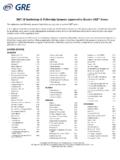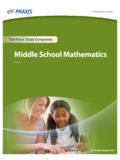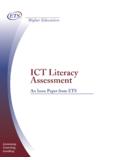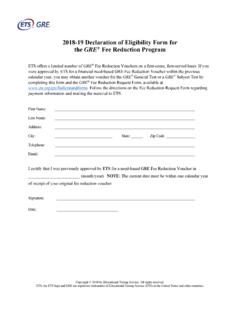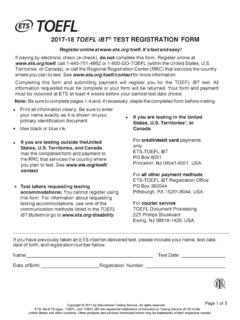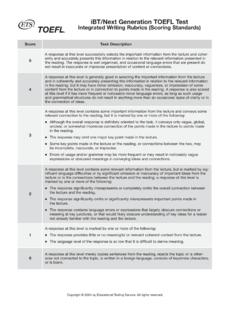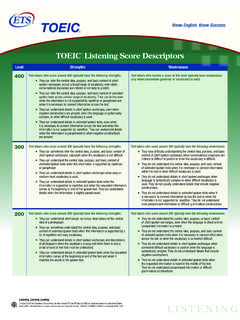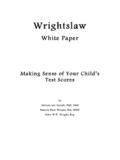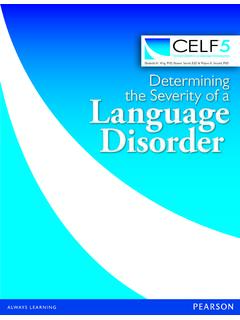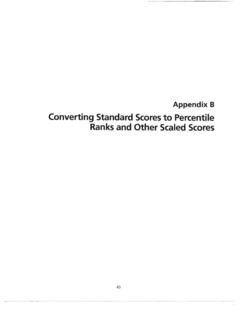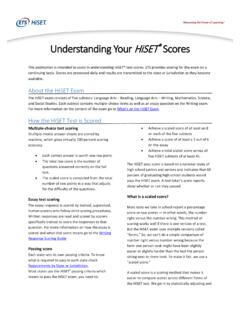Transcription of Understanding Your Praxis Scores 2020-2021
1 Copyright 2020 by Educational Testing Service. All rights reserved. E T S, the E T S logo, Praxis , e-rater, and MEASURING THE POWER OF LEARNING are registered trademarks of Educational Testing Service (E T S). Understanding your Praxis Scores 2020 2021 Selected-Response (SR) QuestionsOn most Praxis tests, each selected-response question answered correctly is worth one raw point, and your total raw score is the number of questions answered correctly on the full test. Selected-response questions are scored by (CR) QuestionsConstructed-response questions are scored by education profession-als in the appropriate content area. These individuals are carefully trained and supervised to assure they apply E T S scoring methods in a fair and accurate manner. Additional statistical checks are made to account for differences in difficulty across editions of a scorers rate your responses to CR questions.
2 Each one works independently and does not know what the other scorer s ratings are. If the two ratings disagree by more than a specified amount, a third scorer rates your response. Under no circumstances does your total score depend entirely on one individual some tests, c-rater is one of the scorers. c-rater is an automated ETS scoring engine that Scores responses to content-based, short-answer questions based on data from thousands of previously scored TestsSome tests consist of one or more essays and a selected-response portion. For some of the Praxis tests that contain both SR and CR items, the ratings assigned by the scorers are simply added together to contribute to your total raw score . On others, the ratings are first multiplied by scoring weights, which can be different for different questions, and the weighted ratings are added to contribute to your total raw score .
3 your raw point score is then converted to a scaled score that adjusts for the difficulty of that particular edition of the the Core Academic Skills for Educators: Writing test, each essay receives a score from at least one trained human reader, using a six-point holistic scale. In holistic scoring, readers are trained to assign Scores on the basis of the overall quality of an essay in response to the assigned task. Both the Informative/Explanatory Essay and the Argumentative Essay are scored by a human reader and e-rater , ETS software that computes a score based on data from thousands of previously scored essays. If the human score and the e-rater score agree, the two Scores are added to become the final score for the essay. If they differ by more than a specified amount, your response is rated by a different human scorer, whose rating is used to resolve the discrepancy.
4 For a list of tests that include both essay and selected-response questions, go to of Raw Scores to scaled ScoresFor most Praxis assessments, E T S develops multiple editions of the same test that contain different sets of test questions conforming to predefined content and statistical specifications. These different editions are commonly called forms. To ensure that Scores obtained from different forms of the same test are comparable, raw Scores are converted to scaled Scores that carry the same meaning regardless of which form was administered. scaled Scores are used to determine whether test takers have passed the test. The summary statistics shown in section IV are presented in the scaled score Word of CautionThe adjustment for difficulty makes it possible to give the same interpretation to identical Scores on different editions of the same test.
5 For example, a reported score of 150 on the Mathematics: Content Knowledge test will reflect approximately the same level of knowl-edge, regardless of which edition of the test was , identical Scores on different tests do not necessarily have the same meaning. A score of 150 on the Mathematics: Content Knowledge test, for example, does not reflect the same level of knowledge as a score of 150 on the Physical Science: Content Knowledge How The Praxis Tests Are Scored The Praxis Assessments are developed and administered by Educational Testing Service (E T S ). Praxis Core Academic Skills for Educators (Core) tests measure academic skills in reading, writing and mathematics. They are designed to provide comprehensive assessments that measure the skills and content knowledge of candidates entering teacher preparation Praxis Subject Assessments include the Subject Assessment/Specialty Area tests.
6 The Content Knowledge for Teaching tests, the Principles of Learning and Teaching (PLT) tests and the ParaPro Assessment are also considered Praxis Subject Performance Range The range of scaled Scores earned by the middle 50 percent of the test takers taking the test. It provides an indication of the difficulty of the Reliability The tendency of pass/fail decisions made on the basis of test takers test Scores to be consistent from one edition of the test to another. E T S computes decision reliability statistics for a number of different combinations of test taker groups and passing The score that separates the lower half of the Scores from the upper score A qualifying score for a single test that is set by the state or licensing score Range The lowest to the highest scaled score possible on any edition of the test. Raw Points On a selected-response test, each raw point corresponds to a single question.
7 On a constructed-response test, the raw points refer to the ratings assigned by the scorers. Raw points on different forms of a test should not be compared; they are not adjusted for differences in the difficulty of the test The tendency of individual Scores to be consistent from one edition of the test to score The reported score that determines whether a test taker has passed the test. scaled Scores are derived from raw Scores and take into account the difficulty of the test form Interval The number of points separating the possible score levels. If the score interval is 10, only Scores divisible by 10 are Error of Measurement A statistic that is often used to describe the reliability of the Scores of a group of test takers. A test taker s score on a single edition of a test will differ somewhat from the score the test taker would get on a different edition of the test.
8 The more consistent the Scores from one edition of the test to another, the smaller the standard error of measurement. If a large number of test takers take a test for which the standard error of measurement is 3 points, about two-thirds of the test takers will receive Scores within 3 points of the Scores that they would get by averaging over many editions of the test. The Summary Statistics section shows the standard error of measurement for many of the Praxis tests, estimated for the group of all test takers taking the test. On some tests, the standard error of measurement could not be estimated because there was no edition of the test that had been taken by a sufficient number of test takers. On other tests, the standard error of measurement could not be adequately estimated because the test consists of a very small number of questions or tasks, each measur-ing a different type of knowledge or Error of Scoring For tests in which the scoring involves human judgment, this statistic describes the reliability of the process of scoring the test takers responses.
9 A test taker s score on one of these tests will depend to some extent on the particular scorers who rate the test taker s responses. The more consistent the ratings assigned to the same responses by different scorers, the smaller the standard error of scoring. If a large number of test takers take a test for which the standard error of scoring is 4 points, about two-thirds of the test takers will receive Scores within 4 points of the Scores that they would get if their responses were scored by all possible scorers. The Summary Statistics section shows the standard error of scoring for several of the Praxis constructed-response tests, estimated for the group of all test takers taking the test. For some constructed-response tests, the standard error of scoring could not be estimated because there was no edition of the test that had been taken by a sufficient number of test takers.
10 The standard error of scoring for a selected-response test is zero, because selected-response scoring is a purely mechanical process with no possibility of disagreement between The extent to which test Scores actually reflect what they are intended to measure. The Praxis tests are intended to measure the knowledge, skills, or abilities that groups of experts determine to be important for a beginning Frequently Asked Questions About Praxis Scores Q Did I pass?A your Test Taker score Report will indicate a PASSED or NOT PASSED status for the highest score earned on each test taken. your highest score will be compared to the state or agency s passing score indicated on your score report. The passing Scores used in the Test Taker score Reports are the passing Scores in effect, according to our records, at either the date the test was taken (Test Date) or at the time the score reports are produced (Report Date).
